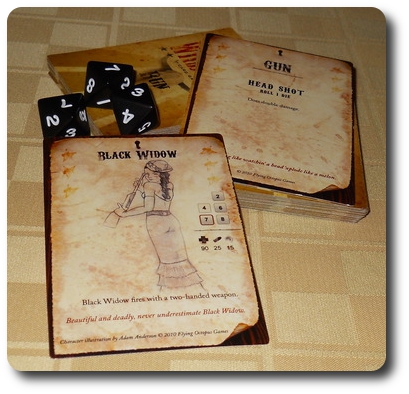
The Basics:
- For ages 7 and up (game designer suggests 12+)
- For 2 to 10 players
- About 30 minutes to complete
Geek Skills:
- Counting & Math
- Logical & Critical Decision Making
- Reading & Writing
- Strategy & Tactics
- Risk vs. Reward
- Hand/Resource Management
- Bluffing and Misdirection
Learning Curve:
- Child – Moderate
- Adult – Easy
Theme & Narrative:
- The fastest and deadliest gunslingers in the territory have gathered to determine who is the best of best, once and for all…
Endorsements:
- Gamer Geek approved!
- Parent Geek approved!
- Child Geek approved!
Overview
In Wild Guns, the players take on the role of some of the most lethal and skilled gunslingers to ever walk the dusty ground of the Old West. There deadly aim and firearm mastery is only matched by their cunning to avoid being hit by their opponent’s bullets. The problem is, if everyone is the “best of the best”, there is almost no room for error in this deadly game of reflex and nerve. Players will have to not only make choices that best utilize their gunfighter’s abilities, but also read their opponent and determine how best to dodge their volley of deadly flying lead. It’s a game of wit, skill, and bluffing with a heavy dose of luck that might let Fate smile on you or shoot you in the back. The town clock has struck 12, High Noon, and it’s time to draw!
Wild Guns is a card game comprised of 50 cards broken down into three specific types. These types are Gunslinger , Run, and Gun cards. The cards are well illustrated and keep to the theme of the Old West throughout. To help make it easier to divide the cards into the three different groups, the cards are labeled “Gun”, “Run”, or “Gunslinger” on the card’s back. The cards are good quality, thick, and durable. Included in the game are 3 eight-sided dice used to determine the outcome of a gunshot.
Note: A second version of this game has been released. Read Wild Guns (version 2) to learn more.
Game Set Up
To set up the game, separate the cards into three different decks; one deck per card type. Shuffle each deck and place face-down. Depending on the number of players, you will deal a specific number of cards from these three decks.
For a 2-player game, you will deal each player 4 Gunslinger cards, 6 Run cards, and 6 Gun cards. The cards should be kept hidden from the other player. Use the following table to determine the number of cards you should deal to each player based on the total number of players in the game. For example in a 5-player game, each player would be given 2 Gunslingers, 4 Run, and 4 Gun cards.
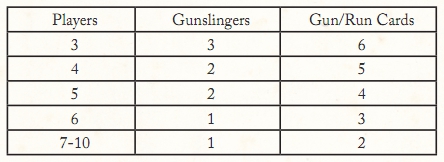
Number of cards to be dealt per player is based on total number of players
The players place, face-down and in sequential order from left to right, their Gunslinger cards. This makes up the order in which the Gunslingers will fight. Survivors move to the next round automatically. Any Gunslinger who falls is replaced by the next Gunslinger in line. Once placed, reveal the first Gunslinger by flipping the card over.
Last, have every player roll the eight-sided die. The player with the highest value is the winner of the “First Shot” and gets to go first.
You will also need some scratch paper and a pencil or some other type of point tracking method to record Gunslinger health throughout the game.
You are now ready to play! Load your gun and grit your teeth because it’s about to get nasty….
The Cards
But before the bullet’s start flying, let’s take a quick moment to talk about the three different card types. A Gunslinger who knows how to use the cards has a better chance of surviving; however, survival is never certain.
The Gun card (offensive moves) displays the name of the type of shot maneuver being used by the Gunslinger. This is important as it is matched to the opponent’s Run cards. Directly under the name of the Gun maneuver is the number of eight-sided dice that are rolled to determine success. Directly under that will be any special rules.
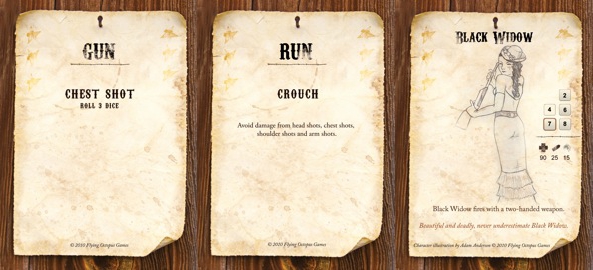
The three card types in the game – from left to right, Gun card, Run card, and Gunslinger card
The Run card (defensive moves) is formatted in the exact same way as the Gun card. Displayed at top is the name of the defensive maneuver being used by the Gunslinger. Directly under the name of the Run maneuver is the description of what Gun maneuvers are avoided. If any listed Gun manuevers match the opponent’s Gun manuever, the shot misses. For example, if the Gun maneuver was “Right Knee Shot” and the Run maneuver was “Jump”, based on the description of the Run maneuver (“avoid damage from knee shots”), the Gunslinger has successfully dodged. Directly under the description are any special rules.
The Gunslinger card lists all the attributes of the active Gunslinger and is therefore the most complex. Other than the name and the flavor text on the Gunslinger card, the following additional information is visible.
- Accuracy Points: These are the numbers that must be rolled on an eight-sided die to score a successful hit if not dodged by a Run card. The value that is highlighted with a darker border (in the below image, that value is “7”) is the Crackshot Accuracy Point value and indicates the successful roll does extra damage.
- Health (cross): The sum total of damage the Gunslinger can take before falling and being discarded.
- Damage (bullet): The amount of normal damage each successful shot rolled by matching the Gunslinger’s Accuracy Points inflicts on the target.
- Crackshot (bullet hole): The amount of extra damage (added to Damage values) if the Crackshot Accuracy Point value is rolled.
- Special Ability: The Gunslinger’s special ability that is always available to the Gunslinger while active.
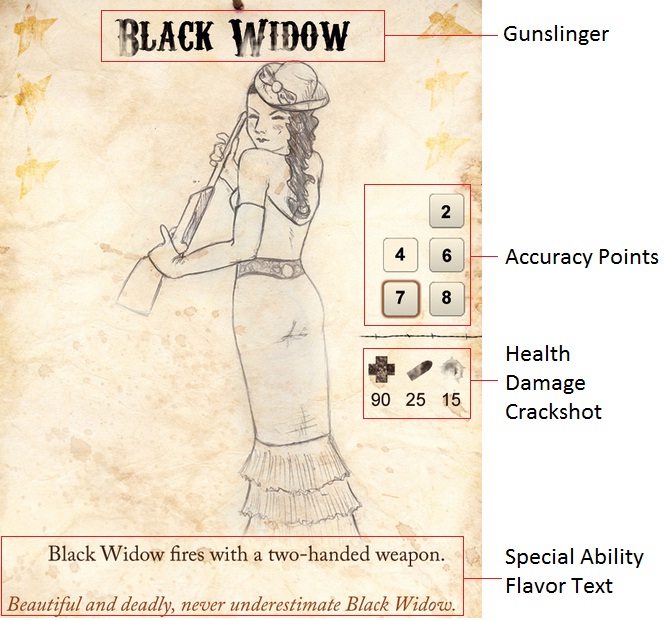
All the parts of a Gunslinger card
Draw On the Count of Three…
The game is broken into three phases for a 2-player game and two phases for 3 or more player game. The game play is different enough for a 2-player game versus a larger group to make special note of each.
For a 2-player game…
The first phase plays out all six sets of Run and Gun cards until a Gunslinger falls.
- Place 1 Gun and 1 Run card, face-down, on the table.
- The First Shot winner reveals their Gun card and their opponent reveals their Run card. If the Run card does not dodge the Gun card, continue. Otherwise, skip to step 4.
- Roll for Accuracy and calculate damage, if any. If the Gunslinger is dead, discard all the remaining Run and Gun cards and the round ends. A new Gunslinger replaces the discarded Gunslinger and the other Gunslinger advances to the next round. Six new Run and Gun cards are dealt to each player and the eight-sided dice are rolled again to determine which player goes first.
- If the player’s shot misses or is dodged, the second player now reveals their Gun card and the opponent reveals their Run card, repeating the steps above.
- After both players have revealed their Run and Gun cards, roll the eight-sided die to determine who goes first and repeat the above steps.
These steps continue until all 6 sets of Run and Gun cards are played out or a Gunslinger falls.
The second phase for a 2-player games is done in the exact same way as the first phase, but only with 3 sets of Run and Gun cards. Again, the steps are followed in sequential order and repeated until all 3 sets of Run and Gun cards are played out or a Gunslinger falls.
The third phase (referred to as the “Deadeye phase”) is essentially sudden death and only happens if both Gunslinger survived the first and second phase. Each player is dealt 1 Run and 3 Gun cards. The players place their Gun cards in the sequential order they want to use them, face-down. Once both players have finished, the Run card for both players is placed face-up. The Gun cards are now revealed as normal but the single Run card is reused for every attack. If both Gungslingers survive, the Gunslinger with more Health advances to the next round. If they both are found to have the equal health, continue with the first phase.
For a 3 or more player game…
Game play is very much like the above except for the following exceptions taken from the rule book:
- There is no Deadeye phase
- Turns revealing Gun cards are taken clockwise from the First Shot winner. The First Shot winner can defer First Shot to another player.
- Any Gunslinger can be attacked.
- Gunslingers can not be defaulted as the winner by the most Health; all other Gunslingers must be at 0 Health.
- Whenever players run out of Run and Gun cards in hand, all Run and Gun cards are shuffled and again dealt to the players.
- Run cards are revealed and stay revealed when the player is attacked, and can be attacked multiple times each Round. Even if you were not attacked that Round, your Run Card is revealed at the end of the Phase and discarded.
- Damage is not resolved until the end of the combat, thus your next Gunslinger is not revealed until after the combat is over and can continue to attack even if their Health is zero until the end of the phase.
- A new round begins when ever a Gunslinger is defeated.
Last Gunslinger Standing
When the gun smoke clears, the last Gunslinger standing (and player) is declared the winner.
Learn more about the game and read the complete rules by visiting the game’s web site on the Game Crafter.
Prediction
I think Wild Guns will be well received by my oldest little geek but will be a complete mystery to my middle little geek. There is a lot of reading and decision making to be had in this game that is just too advanced for a 4-year-old. My 7-year-old, however, shouldn’t have any issues. Game speed will be reduced simply because he is not a fast reader, but this is thinking game and I want to give him all the time he needs.
Another reason this game should be well received is that it’s somewhat like the traditional card game, War, which my little geeks like to play. Major emphasis on “somewhat” here as Wild Guns does not appear to be anywhere as tedious as War and requires a lot more thinking. But because there is already an element of familiarity, Wild Guns will be easier for my little geeks to understand and learn which will, in turn, reduce the level of stress and frustration they might feel when trying to learn a new game they are not at all familiar with.
When I pitched the game to my two oldest little geeks, they were very excited about it. I explained how the cards interacted, how to determine attack outcomes, and the special Gunslinger abilities. We had to go through several examples before my oldest little geek could demonstrate to me he understood what to do with the cards and how they worked together proficiently enough to hold his own in the game. My 4-year-old was having a very hard time with it and he volunteered to be my “partner” after only a few minutes of game explanation.
When I was satisfied my oldest little geek understood the game and he felt confident enough to play, I gave him the Gun and Run decks to shuffle while I shuffled and dealt out the Gunslinger cards. While I did so, I asked each of my little geeks their thoughts on the game so far.
“I like how I get to change what I do every round and I have 4 fighters to play with.” ~ Liam (age 7)
“Can I play the cards on our turn, Daddy?” ~ Nyhus (age 4)
The cards were dealt as Fate would have it and the dusty streets of the small town were as quiet as the grave. A light breeze kicked up a dust devil as a tumbleweed darted between seemingly abandoned buildings. In the distance, a dog barked. I stood there in the hot sun, eyes squinting under my hat as I licked my dry lips. A hundred paces from me stood my son in his faded poncho, his hand over his Colt, trembling. A moment’s pause and we flipped over our cards. The gunfight had begun!
Final Word
Wild Guns is a wild success with my son. He really enjoyed how fast the game moved and how the cards easily let him visualize what the Gunslingers were doing. Each victory felt like a narrow escape from certain doom and each fallen Gunslinger an opportunity to try a new tactic. The game went smoothly and was surprisingly engaging for a game designed to be casual. And casual it is, gut when you are going head-to-head with a little geek who is trying is hardest to win, you can’t help but also get overly engaged and get lost in the moment and momentum.
My 7-year-old has come a very long way in a relatively short amount of time in regards to his understanding of how games work, his ability to comprehend and remember rules, and learning to utilize strategy and tactics. I have heard from others that the “magic age” is around 8-year-old when little geeks suddenly obtain a new ability to “get the game”, as it were. I am rather fortunate that I get to squeeze in a bonus year to play more complicated games that would otherwise not be on the family game table.
If you search for other reviews of this game, you will find again and again comments about the rules. These statements that suggest that the rules are in need of some TLC are accurate. The game could be improved with some simple rule updates and simple editing. I was able to understand the rules fairly quickly but there were portions that were left out suggesting that the assumption was being made that the player would understand what was being discussed. For those who have played many games, this isn’t a problem. It was easy for me to connect the dots and understand the flow. However, Wild Guns is targeting the casual gamer, a demographic that does not play a great number of games or terribly complex ones. As a result, the rules will cause confusion and frustration. The game designer is well aware of some of the shortcomings in the rules and has told me his is going to address them. Because of how the game is designed, the rules can be updated without effecting the cards. Game owners can rest easy knowing that any changes to the rules will be easily added without the need to change cards or require frequent FAQ reviews.
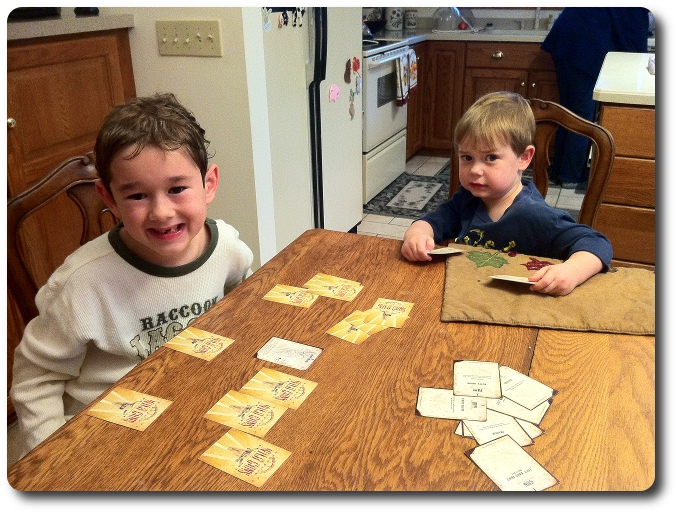
Even with all the chaos and the choking gun smoke in the air, my little geeks and I were smiling throughout the game
Gamer Geeks, Wild Guns is a very casual game but it brings to the table enough depth and thinking to grab your attention. At the surface, this is a game based on luck and randomness, but below its gritty surface is a very interesting meta game where you are trying to outsmart and out maneuver your opponent. You can greatly improve your chances of winning by playing off your Gunslinger’s strengths and your opponent’s weaknesses. To that end, I would suggest that this game is best played with 2 players. Any more than 2 and the level of tactics and strategy is exponentially reduced per player to eventually being nothing more than random outcomes. That is exactly the kind of game a Gamer Geek tries to avoid, but for the casual geek, this will provide a light and fast chaotic gun battle with lots of narrow chaotic fun.
Parent Geeks, a word of caution. The game is approved for its use of strategy and tactics along with the other geek skills listed, but it does simulate violence. While the players are never the direct target of any attack (the poor Gunslingers take all the hits), the fact that guns are being fired might not be what you are looking for. However, if you and your little geeks have no issue with simulated violence in the form of a card game, Wild Guns is going to be a great deal of fun. The game is a vast improvement over your other early little geek combat light games, such as the classic card game, War. Instead of just randomly flipping over a card and comparing values, the players must think and guess what their opponent is going to try to do and then do all they can to either avoid it or beat them to the punch.
Child Geeks, I know Old West films and gunfighter trilogies are not the “in thing” at the moment and robots and Ninjas are all the rage, but you’ll enjoy this game all the same. The game is fast and light with decision making kept to a minimum but with very important outcomes. There is always a margin for error and an even larger margin for continued success. The Gunslingers can take a good deal of damage before being replaced which will keep you in the game long enough to learn as you go and jump back from certain defeat to a nail-biting victory!
Wild Guns does a great job of getting the players down to business quickly and offering an entertaining and challenging game with light mechanics and fast play. The offensive and defensive cards, as well as the Gunslingers, are well-balanced and compliment each other. It’s small enough to fit in a sandwich bag and takes very little space to play. I have put it in my “man purse” to take out to restaurants if the need should arise to entertain my little geeks at the table. There is also enough to the game to keep me interested in it and thinking of different ways to play cards, trying to find the best combos, and the most difficult attacks and defenses to beat. That being said, I desperately want more cards. With only 50 cards in the base game, you quickly go through them and become familiar with what the game has to offer. I have already tried my hand at making new cards and hope to have my vampire cowgirl on the table soon. Until then, my little geeks and I will continue to enjoy Wild Guns and I’m sure you will, too, if you give it a try.
This game was given to Father Geek as a review copy. Father Geek was not paid, bribed, wined, dined, or threatened in vain hopes of influencing this review. Such is the statuesque and legendary integrity of Father Geek.




Nice and thorough review. It’s great that your 7yo is starting to have the gaming world click for him. You gain a gaming partner. Of course, you also ruin him for life. Now he will look at adult casual gamers who are explaining strategy to him (condescendingly) and he will be thinking, “Yep, got that. Can we get on with it now!?” And when he plays you, he will open up the biggest can of whoop-’em he can find!
Ha! So true. I might be raising the worst Gamer in the world or the very definition of a “Perfect Gamer”. In all honesty, I’m shooting for something in the middle. Balance in all things…
Pingback: » Even Pretty Girls Fart Book Review
Pingback: Wild Guns (Version 2) Game Review » Father Geek